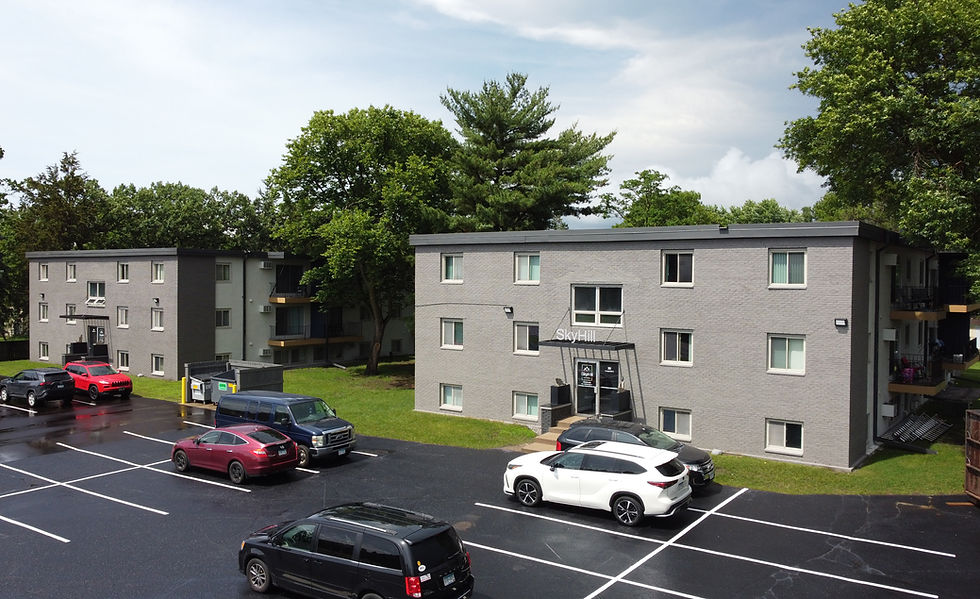What makes a good deal?
- Ridgeview Property Group

- Jun 2, 2023
- 4 min read
Updated: Jan 7

The Ridgeview Report
In order to find success in multifamily investing, I employ a meticulous approach to property acquisition. I seek out properties that not only meet certain performance projections but are located in targeted markets with the potential for growth. My focus is on acquiring properties with upside potential, where I can add value.
Projected Performance
When it comes to projecting performance, I strongly emphasize analyzing and forecasting potential outcomes. A major focus of mine is achieving a cash-on-cash return of 7% to 8% or higher upon stabilization. This ensures a healthy cash flow, making the investment financially viable and providing a safety net in worst-case scenarios. The deal needs to far exceed the risk-free rate, currently nearing 4%. If the projected returns did not exceed this benchmark, the effort involved in acquiring, renovating, managing, and operating the property would not be justified.

Debt
When assessing financing options, certain factors hold significant importance. These include securing a favorable interest rate, considering the loan-to-value (LTV) ratio, and evaluating the amortization schedule. Securing an attractive interest rate is paramount as it directly impacts borrowing costs and overall profitability. Considering the LTV ratio helps determine the amount of financing available relative to the property's value, ensuring a balanced degree of leverage. Evaluating the amortization schedule allows for an assessment of the repayment timeline, enabling a sustainable and efficient debt management strategy. Non-recourse debt is always preferred, but I do personally take on recourse debt as well. (Investors do not take on any recourse) I was fortunate to secure non-recourse debt on my 28-unit property in Jordan, MN. At this property the debt is tied to the building itself, limiting liability and enhancing the overall appeal of the investment. Lastly, opting for long-term debt is preferable as it helps mitigate maturity risk by extending the repayment period. Considering these factors ensures a secure and favorable financing structure for the investment.

Market
Choosing the right market to invest in involves considering certain variables. Population growth is a significant factor as it drives demand for housing, leading to higher occupancy rates and the ability to command higher rent rates. Therefore, investing in areas experiencing population growth can lead to favorable returns.
Selecting a market with landlord-friendly jurisdiction is crucial. It ensures recourse options in case of problematic tenants and allows for renovations and rent increases to maintain and enhance property value. Rent control cities often lack incentives for property owners to improve their apartments, resulting in outdated housing stock. Additionally, reasonable property tax regulations in a jurisdiction are beneficial to avoid excessive tax burdens. *See this week's news article regarding the state of property taxes in Texas*
Opting for "A" and "B" neighborhoods offers numerous advantages. These areas tend to experience consistent rent growth, encounter less property damage and wear, and have a significant advantage when it comes to retaining leasing and management staff. Evaluating the area's median Income, with a target of $60,000 or higher, helps ensure that the tenant demographic has the financial means to fulfill their rental obligations. Furthermore, residents of "A" and "B" class apartments generally possess a greater financial cushion, which enables them to better withstand job loss or financial setbacks. Their resilience in maintaining rental payments reduces the risk of high delinquency rates during economic downturns.
Considering the diversity of employers within the local economy is another essential factor. A broad pool of employers means a property is not overly reliant on a single company or industry for employment. This diversification reduces the risk associated with economic downturns or company-specific issues, providing more stability to the local rental market.
By considering each of these factors, I can make informed investment decisions that increase the likelihood of a successful investment.
-Ben Michel
Ben Michel is the founder of Ridgeview Property Group, an investment firm specializing in acquiring multifamily real estate. Register Here to be notified of available investment opportunities.
Market News
Texas & Taxes Texas real estate investors are currently facing aggressive property tax hikes. According to an article from The Real Deal (2023), property tax assessments in the Dallas-Fort Worth (DFW) area have surged. A study by Houston-based tax consultant O'Connor & Associates reveals that commercial property valuations in Dallas County have increased by nearly 30% compared to the previous year. Hotels experienced the largest spike in values, rising by an average of 53%, followed by a 35% increase for apartments. Some industry professionals argue that the new property assessments do not accurately reflect the current market conditions. They believe that the assessments should consider the trends observed in the latter part of 2022, rather than solely relying on values as of January 1st of the tax year. Source:TheRealDeal.(2023,May 5) Ooof! Property assessments soar in DFW. TheRealDeal. https://therealdeal.com/texas/dallas/2023/05/05/oof-property-assessments-soar-in-dfw/
Tips and Tricks
Terms:
Non-recourse Debt- Non-recourse debt is a type of loan where the lender's sole source of repayment is the collateral securing the loan, typically a specific asset or property. In non-recourse financing, the borrower is not personally liable for the loan. This means that in the event of default or failure to repay the debt, the lender can seize and sell the collateral but generally cannot pursue the borrower's other assets or hold them personally responsible for the remaining debt.
Risk-Free Rate- The risk-free rate refers to the theoretical rate of return that an investor can expect to earn from an investment with no risk or uncertainty. It serves as a benchmark for comparing the potential returns of riskier investments. The risk-free rate is typically based on the yield of government bonds, such as U.S. Treasury bonds, which are considered to have minimal risk of default.



